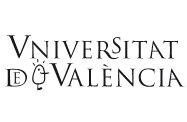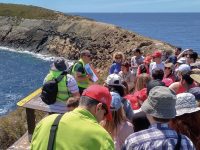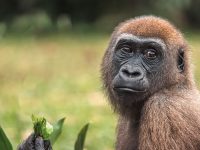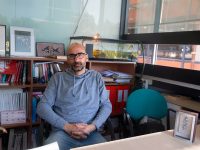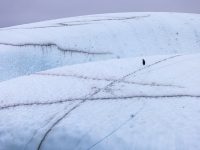Nature as a political question
Alexander von Humboldt and power networks
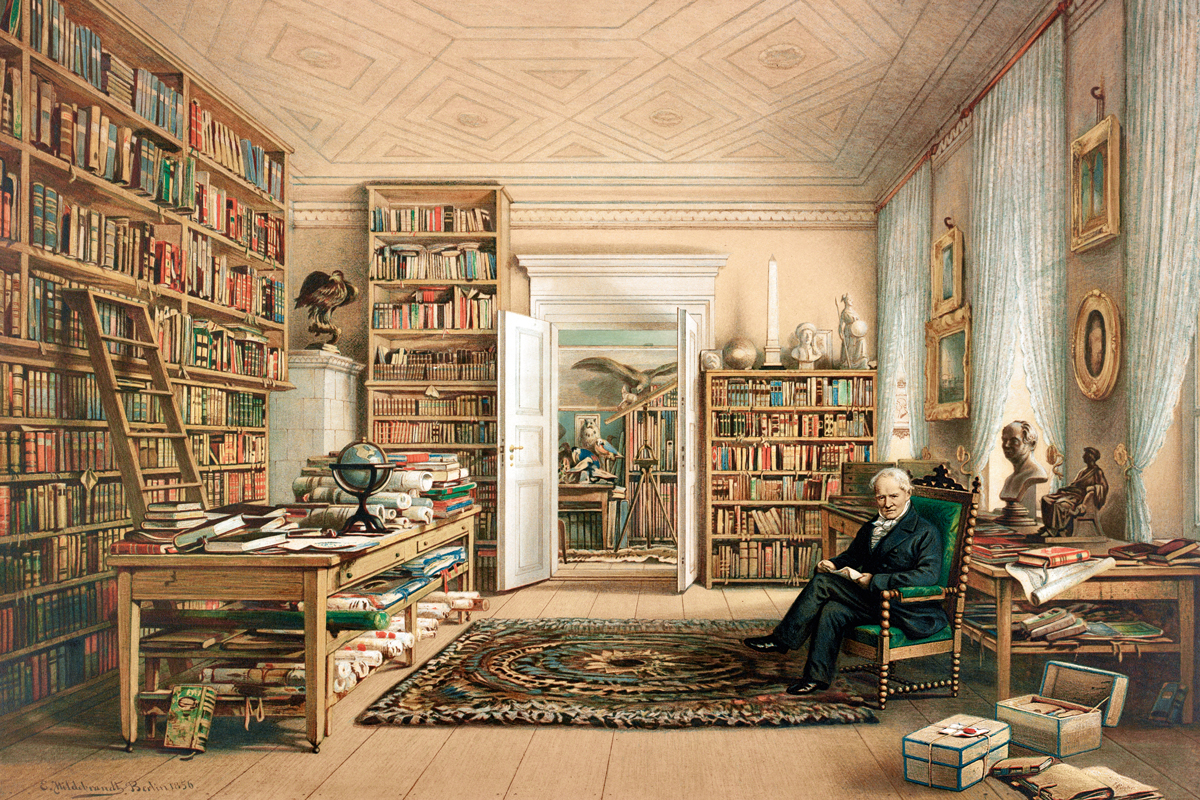
The life and work of the Prussian geographer and naturalist Alexander von Humboldt continues to fascinate, even today. This is partly because his figure concentrates and synthesises the movements, ideas, and even the great contradictions of the time of profound change that was nineteenth-century Europe. One of these great contradictions is the relationship between science and power. While on the one hand science was demanding its autonomy and universal value, its «purity», and objectivity more than ever before, on the other, the field was often entangled in questions of political and economic power. In an era in which European countries were intensifying their race for world control, information and knowledge about nature gave them a vanguard position when it came to managing this control. Here, we situate Alexander von Humboldt’s innovative geographical work in this context.
Keywords: geography, Alexander von Humboldt, nature, networks of power, landscape.

The importance of literature for Humboldt can also be seen on the cover of his «Essay on the geography of plants» (1807), which opened his Journey to the equinoctial regions. Dedicated to his great friend Goethe, the engraving shows the figure of Apollo, god of poetry, lifting the veil on a statue representing Nature. / Mètode
Geography, science, and literary culture
In the 1940s, René de Clozier claimed that Alexander von Humboldt and his compatriot Carl Ritter had been the «founders» of modern geography. Cosmos, published by the former in four volumes between 1845 and 1858, stands out. Although «old-fashioned» in certain respects, according to De Clozier, it was nonetheless interesting. Among other things because, instead of «studying the climatic, botanical, and geological phenomena by themselves and in isolation, Humboldt [examined] them in their reciprocal relationships, in their distribution; that is, according to the principle of coordination which is the basis of geographical inquiries». Therefore, as stated by Ritter himself, what other disciplines «dissociate through the analysis of experimentation, geography examines in the particular order of things, in their exuberant diversity and changeable reality, since nature is not a dead machine» (De Clozier, 1956). However, despite the obvious interest in geography, Humboldt’s influence transcends disciplinary and academic boundaries to reach a part of European literary and book culture.
«Humboldt repeatedly supported the role of literature in the construction of geographical knowledge»
Anyone who is interested in the history of the book and its publication should certainly study the great milestone that Humboldt’s global work represents. The thirty-four volumes of his Personal narrative of a journey to the equinoctial regions of the new continent are a monument to the printing press. The Prussian geographer’s editorial project was so large and ambitious that one is tempted to ask the same question as George Steiner did (2008) about the also monumental Science and civilization in China, by historian Joseph Needham: what if «these thousands of pages of historical and analytical scholarship, these bibliographies with their monographic dimensions, these hundreds of statistical tables, graphs, charts, maps, diagrams, and illustrations somehow constituted a fiction?» In fact, the question is not foolish, not only if we consider the fact that the «border between reality and fiction is subtly fluid», as Steiner (2008) indicates, but also simply because Humboldt himself repeatedly supported the role of literature in the construction of geographical knowledge. In a recent biography, Andrea Wulf (2016) even suggested that Napoleon’s complex relationship with the geographer during the years in which he lived in Paris, between 1808 and 1827, could be the result (apart from the political misgivings resulting from the rivalry between the two countries) of editorial competition between his work and the Description de l’Égypte, a work promoted by Napoleon Bonaparte himself after his military campaign in the country of the River Nile.
«What definitely marked Humboldt’s life was his great journey to the equinoctial regions of the new continent»
The fact that Alexander von Humboldt vindicated literature is evident not only in his prose, but also in the drawing he placed on the cover of his «Essay on the geography of plants», a volume published in 1807 which started the Journey to the equinoctial regions. Dedicated to his great friend Goethe, the engraving shows the figure of Apollo, god of poetry, lifting the veil of a statue representing Nature. As if the geographer was aware that in order to «discover» the ultimate certainties of nature, its deepest secrets, and the human meaning of its multiple manifestations, poetic inspiration was necessary. The philosopher Pierre Hadot recently wrote a book examining this Humboldtian allegory (Hadot, 2015). Humboldt’s vindication of literature, incidentally, also included folklore; this is why Humboldt asked his «noble friends» Jakob and Wilhelm Grimm (Humboldt, 2011, p. 211) for advice when writing the chapter of Cosmos dedicated to the «The image reflected by the external world on the imagination».
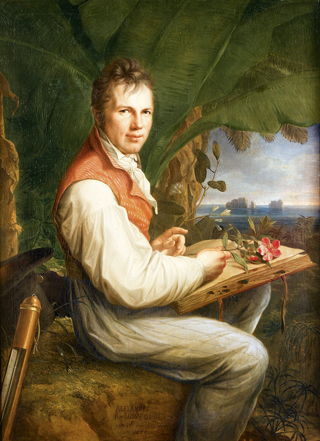
Alexander von Humboldt «invented» nature, especially in relation to its visual representation. In this context, nature ceases to be a spectacle to be contemplated, and a willingness to be included on the scene appears. Scientists collect samples, observes, records, etc. In the picture, a portrait of Humboldt by Friedrich Georg Weitsch (1806). / National Gallery, Berlin
Undoubtedly, this interest in art and literature came from the social environment itself. Born into an educated family, close to the court of the king of Prussia, Humboldt and his brother Wilhelm received a classical and rigorous education. They soon frequented the most liberal circles of the time. These included the «Berlin halls», spaces linked to the enlightened movement, outstanding nuclei of the incipient «Republic of Letters» that emerged during the period between the French Revolution and the 1806 Franco-Prussian War (Arendt, 2004). This is when the geographer became familiar with some of the scientific and philosophical debates of the day. Apart from his time at the University of Göttingen and the Mining Academy in Freiberg, his friendship with Georg Forster (a renowned naturalist and writer with whom he would later travel, partly following the Rhine course, to France and England) is also worth mentioning. Alexander von Humboldt’s Views of Nature, his favourite book – a «combination of scientific information and poetic descriptions», as Andrea Wulf put it – published in 1808, was directly inspired by Forster’s Views of the Lower Rhine, published during the 1790s (Humboldt, 2003; Raffestin, 2016, pp. 40–41). During this same decade, Humboldt would also meet two important figures: Goethe, with whom he had already established a close relationship, and Friedrich Schiller. Together with his brother Wilhelm, the quartet became known as the Circle of Jena and were one of the key centres of promotion of German idealism. While, in some respects, Humboldt substantially disagreed with Schiller’s Naturphilosophie, he coincided in others. What all these figures shared in one way or another was a certain idea of unity, harmony, or «coordination», to put it in De Clozier’s words. This unity was not only to be found in the physical world. It was meant to bridge a gap that modern culture had introduced some time before: between the subject of knowledge and external, objective reality. What is common to all romantic poetry on both sides of the Atlantic, from Coleridge to Emerson, is indeed the effort to overcome this dichotomy and restore the supposedly lost correspondence with the world.
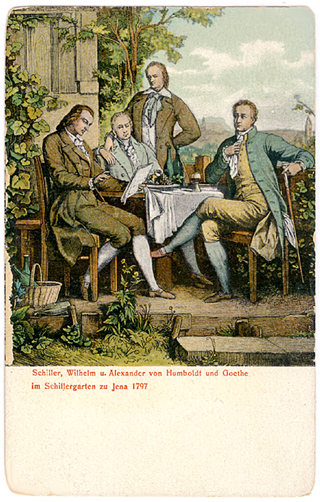
During the 1790s, Humboldt met two pivotal figures: Goethe and Friedrich Schiller. Together with his brother Wilhelm, the quartet will be known as the Circle of Jena and will become one of the promotion centres of German idealism. In the picture, 1797 engraving depicting the four friends: from left to right, Schiller, Wilhelm and Alexander von Humboldt and Goethe. / Mètode
Science and travel, or the networks of power
However, what definitively marked Humboldt’s life was his great journey to the equinoctial regions of the new continent, as the tropics were known in those days. Although the name «America» had already become popular, it was not until a few years later, and in the midst of a dispute for European hegemony over the continent, that the idea of a «Latin America» spread (Mignolo, 2007). With the permission of the Spanish monarch at the time, Carlos IV, Humboldt and Aimé Bonpland, a botanist he had befriended in Paris, departed from A Coruña on 5 June 1799. One of the scientific objectives of the journey was to confirm the existence of a natural canal between the two great river basins of the South American continent, the Orinoco River and the Amazon River. But it is also true that the colonial administration expected detailed information on the natural resources of the empire, especially minable ones. This was, therefore, the first link in the chain of power connecting science and politics, nature, and worldwide economic control. Because of its significance in the geographer’s biography, we should also mention his ascent to Chimborazo, an inactive volcano located in present-day Ecuador and considered the highest mountain on Earth at the time, as well as Humboldt’s visit to the President of the United States, Thomas Jefferson, towards the end of his journey.
Indeed, with the material collected during his ascent of the volcano, the geographer formulated, for the first time, the multiple relationships between apparently heterogeneous physical phenomena, by means of empirical observation. His volume titled «Essay on the geography of plants», which we already mentioned, was the synthesis of all the information he gathered during his stay in Chimborazo. It was in this work that the geographical «principle of coordination» was made explicit for the first time, insofar as Humboldt related botany, climate, and geology to account for plant distribution. The graphical expression of this principle of coordination was equally remarkable because, rather than using existing taxonomic tables, Humboldt placed related variables on the same plane of representation. The result was a «view» of nature or naturgemälde, where nature itself functioned as an interrelated «whole» as well as being dynamic. All this leads us to his friendship with Jefferson.
«With the material collected during his ascent to Chimborazo, Humboldt formulated the relationships between apparently heterogeneous physical phenomena»
Shortly before returning to Europe, Humboldt travelled to Washington, the country’s new capital. His interest in meeting the president of the United States came from some shared affinities, such as a passion for the study of nature. Likewise, the idea of creating an independent republic based on small and medium-sized agricultural and family farms, the social and territorial model of Jeffersonian politics, communed with some of Humboldt’s revolutionary ideas. In turn, the American president was very interested in the information he might have about Mexico, at a time when both countries were disputing their territorial borders. However, Humboldt and Jefferson also disagreed on a transcendental point: the status of Indians, black African Americans, and slavery in general. This is consistent with two different ways of understanding nature: Jefferson advocated slavery because he believed in the inferiority of Indians and black Africans. However, such a hierarchy can only be established if one has a «general conception» of nature, i.e., one based on genera and classes. Conversely, in the words of Ernst Cassirer, Humboldt conceived nature in a «genetic or morphological» way; in other words, for him, the multiple «racial» manifestations had a common «genetic» origin; the different human groups started from a single «trunk» or family, just as, for Goethe, all the plants referred back to the Urform, an archetypal protoform (Cassirer, 2007). Therefore, Humboldt’s abolitionism, his firm belief in the equality of men regardless of their external appearance, not only reflected the conviction of the ideals of the French Revolution (which had strongly influenced him during his trip to Paris with Georg Forster), but it also relied on natural sciences. Hence this is yet another dimension of the networks of power, of the connections between the ideas of nature and social order.
«Humboldt’s abolitionism, reflected not only the conviction of the ideals of the French Revolution; it relied on natural sciences as well»
Once in Europe, Humboldt moved alternately between Paris and Berlin. He knew that the city of light was the ideal environment to expand his studies and spread his ideas. There were pioneering scientific institutions, a consolidated publishing industry, and a stimulating intellectual environment. However, he lived in Berlin for long periods of time, especially from 1827 until his death on 6 May 1859. Despite his liberal and republican ideas, Humboldt was appointed chamberlain to the king of Prussia, and that would chain him to the court. It goes without saying, however, that thanks to this he was able to use his influence to finance part of his scientific activity and promote the projects of others. Once again, he used his scientific prestige and sway within the networks of power to cross the entire Russian territory and reach its eastern borders, beyond the Urals, to the limits of the Altai mountain range. Czar Nicholas I of Russia himself paid for the Prussian geographer’s last journey. His main interest was exploration of the Russian mining regions in order to determine which minerals were the most suitable for coin-making: One last weaving of science and power.
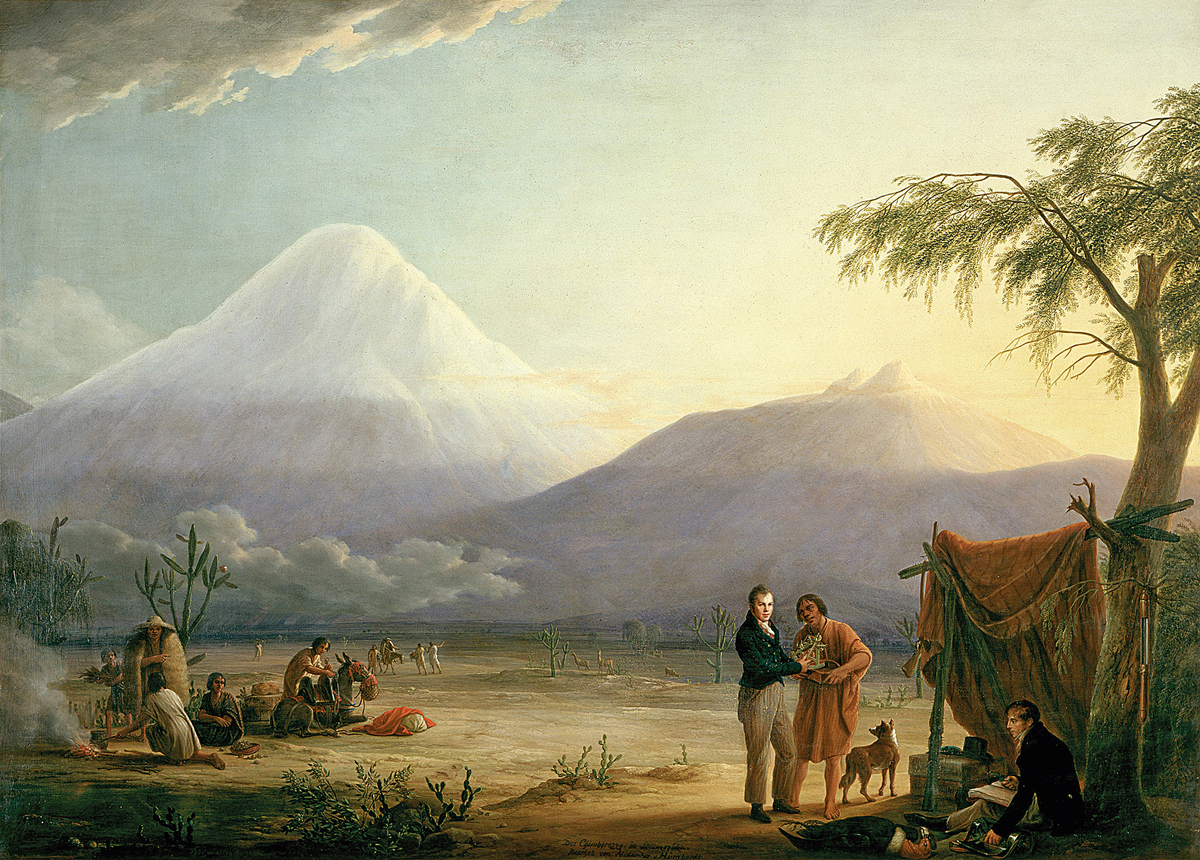
Accompanied by the botanist Aimé Bonpland, Humboldt departed towards the tropics in order to confirm the existence of a natural canal between the Orinoco and Amazon river basins. In the picture, Alexander von Humboldt (standing up, showing a sextant to a native guide) and Aimé Bonpland (working seated) at the foot of the Chimborazo volcano, in an 1810 painting by Friedrich Georg Weitsch. The ascent to the volcano was of great importance for Humboldt’s work. / Mètode
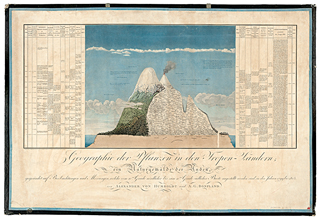
After his ascent to the Chimborazo volcano in what is present-day Ecuador, Humboldt connected botany, climate, and geology to account for the distribution of plants. As a result, he published in his «Essay on the geography of plants» a picture of nature (above these lines) describing how it functions as an interconnected «whole». / Zürich Central Library
Nature, between revolution and representation
Andrea Wulf is correct when she says that Humboldt «invented» nature. From the Chimborazo, the naturalist and traveller «began to see the world differently. He saw the Earth as a great living organism where everything was connected, conceiving a bold new vision of nature that still affects how we understand the world» (Wulf, 2016, p. 24). We must bear in mind, however, that Humboldt’s cultural environment was already conducive to this understanding of nature. In fact, some authors have identified this environment as «neovitalism», which, apart from criticising the fragmentation of knowledge, opposed a particular «mechanistic image of the world», the view of nature as a «dead aggregate»; the idea of a world made up of fragments or parts whose properties are independent from the environment, the system, or the network that encompasses them (Heinz, 1999). Perhaps the spatial image of this conception – which we previously called «generic conception» – is that of the famous cabinets of curiosities, which was relatively known by the aristocracy and bourgeoisie of the time; rooms that showed pieces and objects from the natural world in a decontextualised way, often without any internal coherence. In fact, Humboldt himself, on a visit to one of these displays, was deeply displeased by the demotion of science to museum scraps (Blumenberg, 2000, p. 287). In contrast, to him, the idea of understanding the world and nature as a living, interrelated, and dynamic whole was much more fascinating. However, the Prussian traveller not only «invented» nature in this sense. If we can say that he was somehow original, it was no doubt due to his complete renewal of visual representation. Starting with all these views, including drawings showing Humboldt himself doing fieldwork with his measuring instruments amid an overflowing nature, he was willing to immerse himself in the field. His take on the world was not merely contemplative, he did not present nature as a spectacle, and his ideas and descriptions of the world were not limited to speculation. The scientist collects samples, observes plant species in their habitat, records temperatures, and relates effects and causes within the field, i.e., they are part of the reality they observe. Certainty is not limited to the authority of sacred texts or classic writings: it must be «discovered» through experience.
«Humboldt underlines the interweaving of nature,
science and power»
However, Humboldt’s biography reveals a more complex issue. Of course, he «invented» a new way of observing and representing nature; but most of all, he underlines the interweaving of nature, science and power, as we have also examined here. His journeys had simultaneous scientific and political or economic aims. Just as, beyond the scientific pretext, the mission of the Beagle – the ship used by Darwin in 1831 – was to calculate the exact position of the world’s major ports at a time when the British maritime empire was building its domain. But the relationship between nature and politics could be even more subtle. Let us look, for example, at the debate in the Berlin university circles around certain geological formations: supporters of «Neptunism» claimed that these formations resulted from slow and gradual sedimentation in a primeval sea, whereas others posited that the genesis of rocks, especially basaltic ones, was the result of a sudden cataclysm, the eruptive force of volcanoes. Humboldt’s interest in volcanoes is not surprising in this regard. However, in any case, the debate transcended science, because, apart from religious questions (Neptunism was congruent with the idea of a great universal flood) some academics suggest that different ways of understanding the social change of power were also at stake, at a time when the bourgeoisie was hounding the Old Regime. Unlike reformists, revolutionaries believed that the only way to seize power was through radical, sudden, and violent transformation. Which is why, when Simón Bolívar, who Humboldt had met in Paris and Rome, assumed the leadership of the struggle against colonialist power, he repeatedly used volcanoes as a symbol of revolution (Wulf, 2016). Humboldt’s concept and use of «landscape» is a completely different matter; for the first time, his work considered landscape as more than a mere aesthetic category, but rather also as having a political and scientific function (Farinelli, 1991; Lladó, 2013; Minca, 2007).
«If we can say that he was original in some way, it was no doubt due to his complete renewal of visual representation»
It was probably because Humboldt introduced landscape into the field of natural and social sciences that today his work has been revived after a few years of relative silence. This coincides with what some authors have identified as the «return to the landscape» (Nogué, 2010). This return is reflected beyond the academic debate; an example is the Law 8/2005, passed on 8 June, for the protection, management, and organisation of the landscape, which marks Catalonia’s adherence to the principles of the European Landscape Convention in the year 2000. The principle of «coordination» between disciplines or the global, complex perspective of physical phenomena that featured so prominently in Humboldtian work, mean that his ideas are still valid. But what Humboldt’s geography teaches us is, above all, that nature has now become a political issue, that science is part of the networks of power, and that anyone who wants to study all the aspects of this hot «political question» can do so by discovering the life and work of the Prussian geographer: economic interests, royal court influences, natural-political metaphors, or seemingly objective representations of the world, to name but a few examples.
REFERENCES
Arendt, H. (2004). Un salón berlinés. Revista de Occidente, 282, 105–116.
Blumenberg, H. (2000). La legibilidad del mundo. Barcelona: Paidós.
Cassirer, E. (2007). Rousseau, Kant, Goethe. Filosofía y cultura en la Europa del siglo de las luces. Madrid: Fondo de Cultura Económica.
De Clozier, R. (1956). Las etapas de la geografía. Barcelona: Salvat.
Farinelli, F. (1991). L’arguzia del paesaggio. Casabella, 575–576, 10–12.
Hadot, P. (2015). El velo de Isis. Ensayo sobre la historia de la idea de Naturaleza. Barcelona: Alpha Decay.
Heinz, M. (1999). La obra Cosmos, de Alexander von Humboldt. Estudios de Filosofía, 19–20.
Humboldt, A. (2003). Cuadros de la Naturaleza. Madrid: Los libros de la Catarata.
Humboldt, A. (2011). Cosmos. Ensayo de una descripción física del cosmos. Madrid: Los Libros de la Catarata.
Lladó, B. (2013). Un Geranium humboldtii al jardí geogràfic. Opinió pública, burgesia i paisatge als inicis de la geografia moderna. Documents d’Anàlisi Geogràfica, 59(2), 363–374.
Mignolo, W. (2007). La idea de América Latina. Barcelona: Gedisa.
Minca, C. (2007). Humboldt’s compromise, or the forgotten geographies of landscape. Progress in Human Geography, 31, 179–193. doi: 10.1177/0309132507075368
Nogué, J. (2010). El retorn al paisatge. Enrahonar. An international Journal of Theoretical and Practical Reason, 45, 121–136. doi: 10.5565/rev/enrahonar.224
Raffestin, C. (2016). Géographie buissonnière. Ginebra: Héros-Limite.
Steiner, G. (2008). Els llibres que no he escrit. Barcelona: Arcàdia.
Wulf, A. (2016). La invención de la naturaleza. El nuevo mundo de Alexander von Humboldt. Madrid: Taurus.
